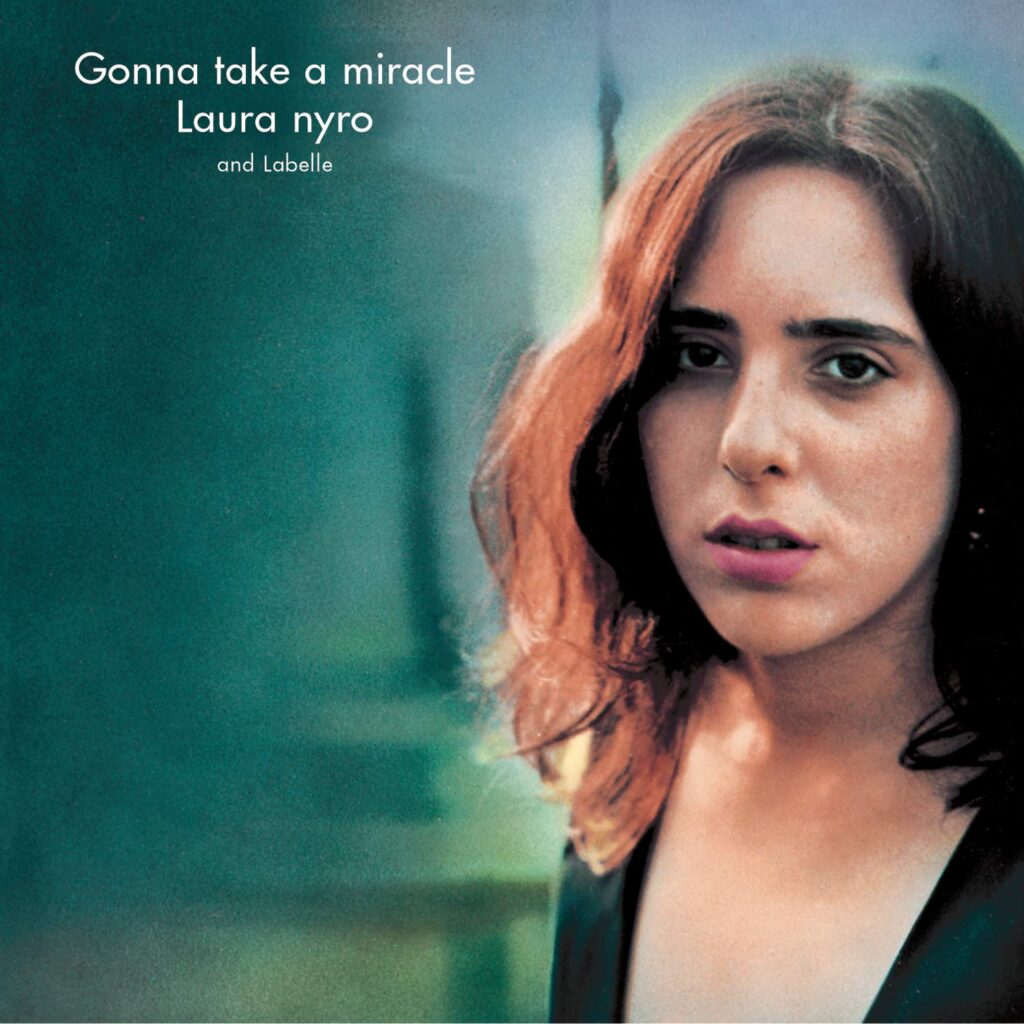The Laura Nyro and Labelle Collaboration: ‘Gonna Take a Miracle’
by Mark Leviton By the time Laura Nyro released her fifth album, Gonna Take a Miracle, in late 1971, she was an established writer of hit songs, but only as performed by other acts. Her own debut single of “Wedding Bell Blues” hadn’t made the Billboard Hot 100 in 1967, but the 5th Dimension took their version to #1 in 1969. As a 45, Nyro’s version of Goffin-King’s “Up on the Roof” barely scraped into the pop charts, while Blood, Sweat and Tears had a huge hit with her “And When I Die,” Barbra Streisand found gold with “Stoney End” and Three Dog Night did as well with “Eli’s Coming.”
By the time Laura Nyro released her fifth album, Gonna Take a Miracle, in late 1971, she was an established writer of hit songs, but only as performed by other acts. Her own debut single of “Wedding Bell Blues” hadn’t made the Billboard Hot 100 in 1967, but the 5th Dimension took their version to #1 in 1969. As a 45, Nyro’s version of Goffin-King’s “Up on the Roof” barely scraped into the pop charts, while Blood, Sweat and Tears had a huge hit with her “And When I Die,” Barbra Streisand found gold with “Stoney End” and Three Dog Night did as well with “Eli’s Coming.”
Her triptych of highly emotional LPs for the Columbia label, Eli And The 13th Confession, New York Tendaberry and Christmas and the Beads of Sweat, had broken new musical ground combining soul, classical and jazz elements, inspiring the adoration of music critics and her devoted cult of fans. Her live concerts tended to be highly charged and often brief, more like sessions of spiritual communion than standard commercial events.
Mixed in with her own challenging compositions, Nyro would often perform favorite tunes she’d devoured during her teenage years in The Bronx, like Leiber-Spector’s “Spanish Harlem,” Goffin-King’s “He’s Sure the Boy I Love” and Bacharach-David’s “Walk on By.” Much of her phrasing comes from studying doo-wop groups like the Marcels, the Clovers, Frankie Lymon and the Teenagers, etc. She also immersed herself in her mother’s vinyl collection of such large emoters as Judy Garland, Nina Simone, Leontyne Price and French classical colorists like Ravel and Satie.
Gonna Take a Miracle is Nyro’s tribute to the vocal groups and songwriters who continued to thrill and inspire her, 10 tracks recorded at Philadelphia’s Sigma Sound Studios with producers Kenneth Gamble and Leon Huff, a crew of expert musicians and the R&B trio Labelle as featured backing vocalists.
Vicki Wickham, the British producer of the popular TV showcase Ready Steady Go!, was now living in New York City, and hooked up Nyro with her management client Labelle, a group that had grown out of the early ’60s quartet Patti LaBelle and the Blue Belles. Labelle, which included Sarah Dash and Nona Hendryx, had already recorded their take on Nyro’s “Time and Love” for their Warner Bros. Records debut LP; Nyro was thrilled to meet Patti when Wickham brought them together. “Once we met, we became like soul sisters,” Patti Labelle recalled for Michele Kort’s Nyro biography Soul Picnic. “It was an instant bond.”
Nyro worked up the arrangements, based on her piano parts and judicious re-imagining of the original material, with Gamble and Huff in a supporting production role and Tim Geelan engineering crisply. String and horn arrangements by Bobby Martin, Lenny Pakula and Bell were supplied as needed.
As Gamble told Kort, “We tried to push her as hard as we could, but I’d always be on her side. I remember Laura Nyro as the girl with the flower in her hair. Always smiling and soft and very sensitive.”
Labelle thought Nyro worked a bit too slowly for their liking, and after a few days of relative inaction in the studio, Patti bet Huff $1,000 they could complete their parts in a day if given the chance. She says she collected her winnings after a five-hour session: “Whenever we made a mistake that sounded cool, we left it in, even if it sounded flat. If it wasn’t too broke, we weren’t going to fix it.” Their contributions are never less than to-die-for.
Handclaps lead off “I Met Him on a Sunday,” originally cut by the Shirelles for Decca in 1958. It maintains its majestic a cappella groove until the band enters, with percussionist Vincent Montana Jr.’s cowbell to the fore. The last moments are given to Nyro’s ethereal outro over one of her characteristic Debussy-like piano chords.
Nyro’s in an expansive emotional space from the very start of “The Bells”; by the time she wails “Do you hear what I hear/When your lips are kissing mine/Can you hear the bells darling/Can you hear them when I’m kissing you,” she somehow has tears in her voice. The Originals did this Marvin Gaye co-write for Motown’s Soul subsidiary label in 1970, and it was excellent without ever unleashing the painful yearning that Nyro has at her command. At the two minute mark Patti and Nyro let their voices rise in tandem ecstasy, evoking a desperation for love that is shocking. “The Bells” in Nyro’s conception attains a mythic quality, a secular hymn.
A medley of “Monkey Time” (a hit for Major Lance written by Curtis Mayfield) and “Dancing in the Street” (one of Martha and the Vandellas’ biggest records) is pure fun. Instrumental highlights include Jim Helmer’s aggressive drumming, bongos from Larry Washington, congas by Nydia Mata, and Hammond B-3 organ from Lenny Pakula. Like most of the LP, this sounds like a joyful first take, with the immediacy of an in-studio party. The two other very upbeat ravers on the album, “Jimmy Mack” and “Nowhere to Run,” (more Vandellas repertoire), are likewise loose confections. They show off Labelle, but certainly don’t improve on the originals. “Nowhere to Run” is plumped up from three minutes to five with a long, repetitive coda that could have been faded without damage.
“Desiree” takes things back to heart-on-the-sleeve territory. Nyro’s “Oh my darlings” are laid against vibraphone, and she handles her own background vocals on a song originally done by the Charts in 1957, when she (going by her family birth name Laura Nigro) was 10 years old.
“You’ve Really Got a Hold on Me,” one of Smokey Robinson’s greatest million-sellers for the Miracles, is launched by Nyro’s gospel piano, then a tremendous call-and-response with Labelle, buttressed by Ronnie Baker’s bass lines and either Norman Harris or Roland Chambers on guitar. At 1:45 the track kicks up a notch, with Patti prominent and some very Nyro-style shimmering harmonies, before Nyro’s inspired addition of a nearly breathless repetition of “Hold me baby and don’t turn me loose” to close the performance with a funkier pallet than Robinson used.
“Spanish Harlem” borrows a bit from the Drifters’ original (bongos, vibraphone) but contains a very different horn arrangement. Once again, Nyro shows her way of sliding from note to note, creating long lines of melody that seem to float. She’s clearly aware of the original Ben E. King vocal, but finds ways to approach the lyrics from a different, and more feminist, angle. She repeats the lyrical image of the rose growing through the concrete as if she can’t believe the flower’s audacity and strength. She makes the words live: “With eyes as black as coal/He looks down in my soul/And starts a fire there.”
The album’s final tracks, “The Wind” and “It’s Gonna Take a Miracle,” are exceptional in different ways. Nyro no doubt knew “The Wind” from both Nolan Strong and the Diablos’ 1954 version and the Jesters’ 1960 update, and leans heavily into the eeriness of the Diablos’ version, overdubbing the backing vocals herself, echoing in the sonic distance. Listen to her superb breath control, moving her voice from a whisper to full-throated lamentation: “Wind, wind blow, blow wind, wind/When the cool summer breeze/Sends a chill down my spine/And I long for my love’s sweet caress/I know he is gone but my love lingers on/In a dream that the wind brings to me.” It’s a chilling performance.
On an album of indelible performances, the title track still packs a wallop. The Baltimore girl group the Royalettes’ 1965 original, written by Teddy Randazzo, Bobby Weinstein and Lou Stallman, had the drama of other Phil Spector-ish Randazzo productions (including Little Anthony and the Imperials’ “Hurt So Bad” and “Goin’ Out of My Head”), but Nyro brings even more pathos, and lets herself get a little out of control vocally, crying “Loving you so/I was too blind to see/You letting me go/But now that you’ve set me free/It’s gonna take a miracle/To make me love someone new/’Cause I’m crazy for you.” The string arrangement is stupendous, and the bridge section has a powerfully constructed echoing of lyrics between Nyro and Labelle when they reach peaks on “Though I know I can’t get forget about you/I promise I will show you how much you’re turning me around/destroying me.”
Gonna Take a Miracle never charted higher than #46 on the Billboard album charts after its Nov. 17, 1971, release, and the title cut didn’t crack the Hot 100 as a 45 rpm disc. The critical appraisals were mixed, although her fans embraced the set, and cheered when she brought Labelle onto the stage for the encores during several 1971-72 tour dates. Reviewing a London show without Labelle, Richard Williams of The Times praised the “oldies” in the set: “These she transformed into her personal property by superbly straightforward alternative modulations and by subjecting them to her own feeling for rhythm.”
In Rolling Stone, Lenny Kaye quipped, “If nothing else, Gonna Take a Miracle bears witness to the fact that Laura Nyro has the best record collection on Central Park West.” (Her management wrote him a letter reminding him she was proud to be from the more working class Bronx.)
Related: Our review of Nyro’s previously unreleased Live in Japan LP
An expanded CD version of the album released in 2002 includes four live recordings of Nyro doing “Ain’t Nothing Like the Real Thing,” “(You Make Me Feel Like) A Natural Woman,” “O-o-h Child” and “Up on the Roof,” from concerts before the Labelle sessions. Other songs considered for the LP, including the Gamble-Huff co-write “Cowboys to Girls,” were apparently never cut.
Nyro’s complicated life and career are covered with sensitivity in Michele Kort’s book; a documentary based on it is reportedly in production, with Nyro’s son Gil as associate producer. She had a love-hate relationship with the music business, and spent years avoiding the limelight, then returning to it, as her influence as a singer and songwriter kept growing despite long absences.
Today, Laura Nyro invariably shows up on “best female singer-songwriter” lists, alongside Joni Mitchell, Carole King, Dolly Parton, Stevie Nicks, Sandy Denny, etc. Nyro died of ovarian cancer in 1997, at the age of 49. She was posthumously inducted into the Songwriters Hall of Fame in 2010 and the Rock and Roll Hall of Fame in 2012.
Sarah Dash passed away in 2021. Patti LaBelle is still an actress and singer, and turned 80 on May 24, 2024. Nona Hendryx is active in music as well. Gonna Take a Miracle is still on Patti’s mind: “I will always cherish my memories of making this album with Laura,” she’s written. “We became best of friends and she became my son’s godmother. She was a true artist and an incredible spirit. And the songs…what beautiful inspiration!”
[Nyro’s recordings are available in the U.S. here and in the U.K. here.]
Watch Bette Midler induct Nyro into the Rock & Roll Hall of Fame
- Bob Dylan’s ‘Desire’: Story Time - 01/05/2026
- Smokey Robinson & the Miracles’ ‘Going to a Go-Go’: Life of the Party - 11/11/2025
- Patti Smith’s ‘Horses’: Poetry In Motion - 11/10/2025






No Comments so far
Jump into a conversationNo Comments Yet!
You can be the one to start a conversation.